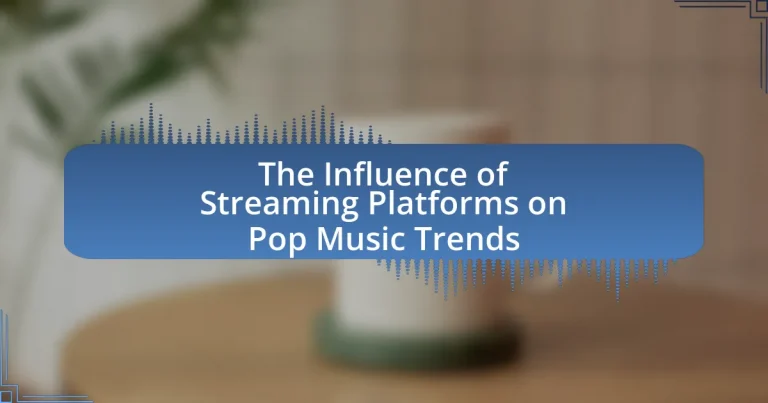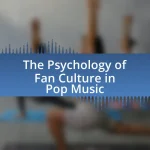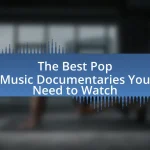The article examines the significant influence of streaming platforms on pop music trends, highlighting how services like Spotify and Apple Music shape music consumption and promotion through algorithms and curated playlists. It discusses the transformation in listening habits, the impact of user interfaces, and the role of data analytics in enhancing artist visibility and marketing strategies. Additionally, the article addresses the challenges artists face regarding revenue distribution and the necessity to adapt their music styles to fit streaming preferences. Overall, it provides insights into the evolving landscape of pop music driven by digital platforms and emerging technologies.
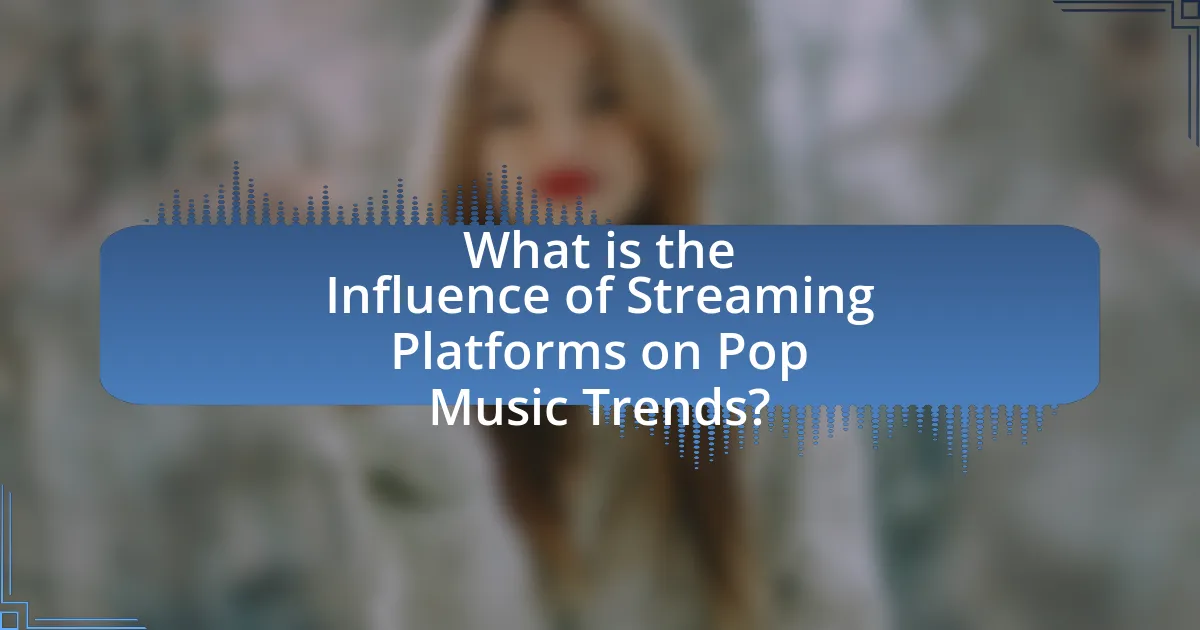
What is the Influence of Streaming Platforms on Pop Music Trends?
Streaming platforms significantly influence pop music trends by shaping how music is consumed and promoted. These platforms, such as Spotify and Apple Music, utilize algorithms that curate playlists and recommend songs, which can propel certain tracks to viral status. For instance, Spotify’s “Today’s Top Hits” playlist has been known to boost songs into the mainstream, leading to increased streaming numbers and chart success. Additionally, data from the Recording Industry Association of America (RIAA) indicates that streaming now accounts for over 80% of music industry revenue, highlighting its central role in determining which artists and genres gain popularity. This shift has led to a more diverse range of sounds in pop music, as emerging artists can gain exposure without traditional gatekeeping from record labels.
How have streaming platforms changed the way we consume pop music?
Streaming platforms have fundamentally transformed the consumption of pop music by providing instant access to vast libraries of songs and personalized listening experiences. This shift has led to a decline in traditional album sales, with a 2020 report from the Recording Industry Association of America indicating that streaming accounted for 83% of the music industry’s revenue, highlighting the dominance of platforms like Spotify and Apple Music. Additionally, algorithms on these platforms curate playlists based on user preferences, which influences listening habits and promotes new artists more effectively than traditional radio. This change has democratized music access, allowing listeners to discover diverse genres and artists globally, reshaping the landscape of pop music consumption.
What are the key features of streaming platforms that impact music consumption?
The key features of streaming platforms that impact music consumption include personalized recommendations, accessibility, and social sharing capabilities. Personalized recommendations utilize algorithms to analyze user behavior and preferences, leading to tailored playlists that enhance user engagement and discovery of new music. Accessibility allows users to stream music anytime and anywhere, significantly increasing the volume of music consumed; for instance, Spotify reported over 365 million monthly active users as of 2021, highlighting the platform’s reach. Social sharing capabilities enable users to share their favorite tracks and playlists with friends, fostering community and influencing trends, as evidenced by the rise of viral hits on platforms like TikTok, which often originate from shared music content.
How do user interfaces of streaming platforms affect listening habits?
User interfaces of streaming platforms significantly influence listening habits by shaping user engagement and content discovery. Intuitive designs and personalized recommendations encourage users to explore new music, leading to increased consumption of diverse genres. For instance, a study by the University of Southern California found that platforms with algorithm-driven playlists, like Spotify, result in users discovering 30% more new artists compared to traditional radio. Additionally, features such as autoplay and curated playlists keep users engaged for longer periods, which can lead to habitual listening patterns. These interface elements directly affect how often and what types of music users choose to listen to, ultimately shaping broader pop music trends.
Why are streaming platforms significant in shaping pop music trends?
Streaming platforms are significant in shaping pop music trends because they provide unprecedented access to a vast array of music, allowing listeners to discover and share songs easily. This accessibility has led to the rapid spread of new artists and genres, as evidenced by the fact that in 2020, over 60% of music consumption in the U.S. came from streaming services, according to the Recording Industry Association of America. Additionally, algorithms used by these platforms curate personalized playlists, influencing user preferences and promoting specific tracks, which can propel songs to viral status. For instance, the song “Old Town Road” by Lil Nas X gained popularity largely due to its exposure on TikTok and streaming platforms, demonstrating how these services can dictate trends in pop music.
What role do algorithms play in promoting pop music on streaming platforms?
Algorithms play a crucial role in promoting pop music on streaming platforms by analyzing user data to personalize music recommendations. These algorithms utilize machine learning techniques to assess listening habits, preferences, and behaviors, allowing platforms to curate playlists and suggest songs that align with individual tastes. For instance, Spotify’s Discover Weekly playlist is generated through algorithms that evaluate user interactions, leading to increased exposure for pop artists whose music matches the identified preferences. This targeted promotion not only enhances user engagement but also drives streaming numbers, contributing to the overall success of pop music in the digital landscape.
How do playlists influence the popularity of pop songs?
Playlists significantly influence the popularity of pop songs by providing curated exposure to a wide audience. When a song is featured on popular playlists, it gains immediate visibility, leading to increased streaming numbers and potential chart success. For instance, Spotify’s “Today’s Top Hits” playlist has been known to propel songs to the top of the charts, as seen with tracks like “Blinding Lights” by The Weeknd, which gained massive traction after being included in such playlists. This curated exposure not only boosts streaming counts but also enhances the song’s chances of being shared and discussed, further amplifying its reach and popularity.
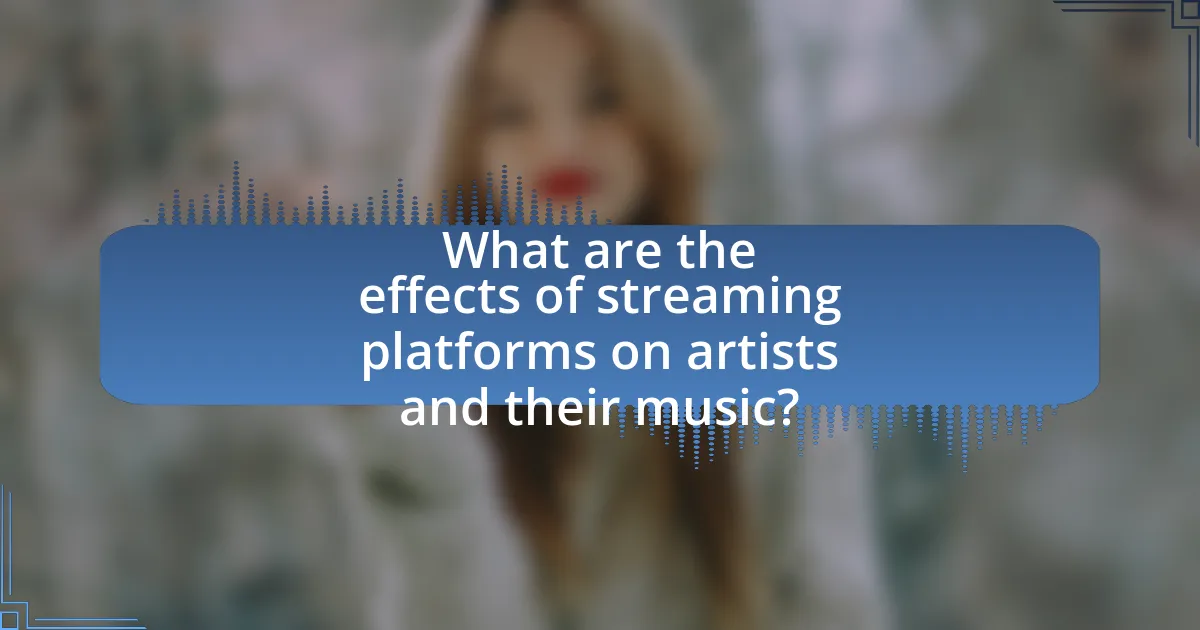
What are the effects of streaming platforms on artists and their music?
Streaming platforms significantly impact artists and their music by altering revenue models, exposure, and music consumption patterns. Artists often receive lower per-stream payouts compared to traditional sales, which can diminish overall income; for instance, Spotify reportedly pays between $0.003 and $0.005 per stream. Additionally, these platforms provide unprecedented access to global audiences, allowing independent artists to reach listeners without the backing of major labels. This democratization of music distribution can lead to diverse musical trends, as artists experiment with genres to capture listener attention. Furthermore, data analytics from streaming services enable artists to understand audience preferences, influencing their creative decisions and marketing strategies.
How do streaming platforms impact the way artists create music?
Streaming platforms significantly influence how artists create music by prioritizing shorter song lengths and catchy hooks to enhance listener engagement. This shift is driven by algorithms that favor tracks with high replay value, leading artists to focus on producing music that captures attention quickly. A study by the University of Southern California found that the average song length has decreased from over four minutes in the early 2000s to around three minutes in recent years, reflecting this trend. Additionally, streaming data analytics provide artists with insights into listener preferences, enabling them to tailor their music to meet audience demands more effectively.
What trends in music production have emerged due to streaming?
Streaming has led to several significant trends in music production, primarily characterized by shorter song lengths and a focus on singles over albums. As streaming platforms prioritize tracks that engage listeners quickly, producers are increasingly crafting songs that are around two to three minutes long, which aligns with listener behavior that favors quick consumption. Additionally, the rise of playlists has shifted the focus from traditional album releases to standalone singles, encouraging artists to release music more frequently to maintain visibility on these platforms. This trend is supported by data showing that songs under three minutes are more likely to be streamed and shared, reflecting the changing dynamics of music consumption in the digital age.
How do artists adapt their styles to fit streaming platform preferences?
Artists adapt their styles to fit streaming platform preferences by creating shorter, more engaging tracks that cater to listener habits. This adaptation is driven by the need to capture attention quickly, as data shows that songs under three minutes tend to perform better on platforms like Spotify and Apple Music. Additionally, artists often incorporate catchy hooks and repetitive choruses to enhance shareability and playlist placement, which are crucial for visibility in the streaming ecosystem. For instance, a study by the University of Southern California found that the average song length has decreased over the past decade, reflecting the influence of streaming metrics on music production.
What challenges do artists face with streaming platforms?
Artists face significant challenges with streaming platforms, primarily related to revenue distribution and visibility. The revenue model of streaming services often results in artists receiving a fraction of a cent per stream, which can lead to financial instability, especially for independent musicians. For instance, according to a 2021 report by the Music Industry Revenue, artists earn an average of $0.003 to $0.005 per stream, making it difficult for them to sustain a living solely from streaming income.
Additionally, the algorithms used by these platforms can limit exposure for emerging artists, as established names often dominate playlists and recommendations. This creates a barrier for new talent to gain traction and reach wider audiences. A study by the University of Southern California in 2020 highlighted that over 70% of listeners primarily engage with a small percentage of popular artists, further complicating the landscape for lesser-known musicians.
These challenges underscore the complexities artists face in navigating the streaming ecosystem while trying to maintain their artistic integrity and financial viability.
How does revenue distribution work for artists on streaming platforms?
Revenue distribution for artists on streaming platforms typically operates through a pro-rata model, where revenue is generated from subscriptions and advertising, then divided among rights holders based on the number of streams. For instance, Spotify allocates approximately 70% of its revenue to rights holders, which includes record labels, songwriters, and the artists themselves. The exact amount an artist receives can vary significantly depending on their contract with the label and the platform’s payout structure. According to a 2021 report by the Music Industry Revenue Report, the average payout per stream is around $0.003 to $0.005, illustrating the challenge for artists to earn substantial income solely from streaming.
What are the implications of streaming metrics on artist visibility?
Streaming metrics significantly enhance artist visibility by providing data-driven insights into listener engagement and preferences. These metrics, such as play counts, skip rates, and playlist placements, allow artists and their teams to identify trends and target audiences effectively. For instance, a study by MIDiA Research in 2021 indicated that artists with higher streaming numbers are more likely to be featured on prominent playlists, which can lead to increased exposure and fan growth. Additionally, platforms like Spotify and Apple Music utilize algorithms that promote songs based on streaming performance, further amplifying an artist’s reach. Thus, streaming metrics serve as a crucial tool for artists to navigate the music industry and optimize their promotional strategies.

How do streaming platforms influence pop music marketing strategies?
Streaming platforms significantly influence pop music marketing strategies by prioritizing data-driven approaches that enhance audience engagement and reach. These platforms, such as Spotify and Apple Music, provide artists and labels with analytics on listener behavior, allowing for targeted marketing campaigns. For instance, Spotify’s algorithmic playlists, like Discover Weekly, enable songs to gain exposure based on user preferences, leading to increased streams and visibility. Additionally, the rise of social media integration, particularly TikTok, has transformed how music is promoted, with viral trends driving song popularity and necessitating real-time marketing adaptations. This shift towards digital-first strategies reflects the changing landscape of music consumption, where traditional marketing methods are increasingly supplemented or replaced by streaming-centric tactics.
What marketing techniques are most effective on streaming platforms?
Influencer marketing is one of the most effective techniques on streaming platforms. This approach leverages popular figures to promote content, significantly increasing visibility and engagement. For instance, a study by Nielsen found that 92% of consumers trust recommendations from individuals over brands, highlighting the effectiveness of influencer partnerships in driving audience engagement on platforms like Spotify and Apple Music. Additionally, targeted advertising based on user data allows for personalized marketing strategies, which can lead to higher conversion rates. According to a report by eMarketer, digital audio advertising spending is projected to reach $4.8 billion by 2023, underscoring the growing importance of tailored marketing efforts in the streaming landscape.
How do social media and streaming platforms work together in music promotion?
Social media and streaming platforms collaborate in music promotion by leveraging their unique strengths to enhance artist visibility and audience engagement. Streaming platforms like Spotify and Apple Music provide access to vast music libraries and personalized playlists, while social media platforms such as Instagram and TikTok facilitate direct interaction between artists and fans. For instance, artists can share snippets of their songs on TikTok, encouraging user-generated content that can lead to viral trends, which in turn drives streams on platforms like Spotify. According to a report by the International Federation of the Phonographic Industry (IFPI), 70% of music listeners discover new music through social media, highlighting the effectiveness of this synergy in reaching wider audiences and boosting streaming numbers.
What role do collaborations play in enhancing visibility on streaming platforms?
Collaborations significantly enhance visibility on streaming platforms by leveraging the combined fan bases of the artists involved. When two or more artists collaborate, they create a cross-pollination effect, where each artist’s audience is exposed to the other’s music, leading to increased streams and engagement. For instance, a study by Nielsen Music found that collaborations can lead to a 50% increase in streaming numbers for the participating artists, as fans are more likely to share and promote the collaborative work. This strategic partnership not only boosts individual artist profiles but also drives algorithmic recommendations on platforms like Spotify and Apple Music, further amplifying their reach.
How can artists leverage streaming platforms for success?
Artists can leverage streaming platforms for success by utilizing data analytics to understand listener preferences and optimize their release strategies. Streaming platforms provide artists with access to detailed metrics about their audience, including demographics, listening habits, and geographic locations. By analyzing this data, artists can tailor their music releases, marketing efforts, and promotional activities to better align with their audience’s interests. For instance, Spotify’s “Spotify for Artists” tool allows musicians to track their performance and adjust their strategies accordingly, leading to increased engagement and fan loyalty. Additionally, artists can collaborate with playlists and influencers on these platforms to enhance their visibility, as curated playlists often drive significant streams and new listener acquisition.
What best practices should artists follow to maximize their reach on streaming platforms?
Artists should focus on consistent content release, engaging with their audience, and utilizing data analytics to maximize their reach on streaming platforms. Regularly releasing new music keeps listeners engaged and increases visibility on algorithms that favor active artists. Engaging with fans through social media and live performances fosters a loyal community, which can lead to increased streaming numbers. Additionally, analyzing streaming data helps artists understand listener preferences and optimize their marketing strategies. According to a report by MIDiA Research, artists who actively engage with their audience see a 30% increase in streaming engagement, demonstrating the effectiveness of these practices.
How can emerging artists effectively use streaming platforms to build their fanbase?
Emerging artists can effectively use streaming platforms to build their fanbase by leveraging playlist placements, engaging with listeners through social media, and utilizing data analytics to understand audience preferences. Playlist placements on platforms like Spotify and Apple Music can significantly increase visibility, as curated playlists often reach millions of listeners; for instance, songs featured on popular playlists can see a 200% increase in streams. Engaging with listeners through social media allows artists to create a personal connection, fostering loyalty and encouraging shares, which can amplify their reach. Additionally, utilizing data analytics tools provided by streaming services helps artists identify which songs resonate most with their audience, enabling them to tailor their marketing strategies effectively.
What future trends can we expect from streaming platforms and pop music?
Streaming platforms will increasingly prioritize personalized content and data-driven recommendations, shaping the future of pop music consumption. As algorithms become more sophisticated, platforms like Spotify and Apple Music will enhance user experiences by curating playlists tailored to individual listening habits, which can lead to the rise of niche genres and artists. According to a 2022 report by MIDiA Research, over 60% of users prefer personalized playlists, indicating a strong demand for customized music experiences. Additionally, the integration of social media features within streaming services will facilitate viral trends, allowing songs to gain popularity rapidly through platforms like TikTok, which has already demonstrated significant influence on chart performance. This trend suggests that the intersection of social media and streaming will continue to drive pop music trends, making it essential for artists to engage with audiences across multiple platforms.
How might advancements in technology further influence pop music trends?
Advancements in technology will likely continue to shape pop music trends by enhancing production techniques and altering distribution methods. For instance, the rise of artificial intelligence in music production allows for the creation of unique sounds and compositions, which can lead to new genres and styles emerging within pop music. Additionally, streaming platforms utilize algorithms to analyze listener preferences, enabling artists to tailor their music to meet audience demands more effectively. This data-driven approach has already transformed how music is marketed and consumed, as evidenced by the success of tracks that are optimized for streaming playlists. Furthermore, innovations in virtual reality and augmented reality could create immersive concert experiences, attracting more fans and influencing the types of performances that become popular.
What potential changes in user behavior could affect the music industry?
Potential changes in user behavior that could affect the music industry include shifts towards increased consumption of short-form content and a preference for personalized playlists. As users increasingly gravitate towards platforms like TikTok, which emphasizes brief audio clips, the demand for music that fits these formats may rise, influencing artists to create shorter songs. Additionally, the growing reliance on algorithm-driven recommendations on streaming services like Spotify can lead to a homogenization of music styles, as artists may tailor their work to fit popular trends identified by these algorithms. This shift in user behavior towards bite-sized content and personalized listening experiences can significantly reshape the music landscape, impacting how artists produce and market their music.
